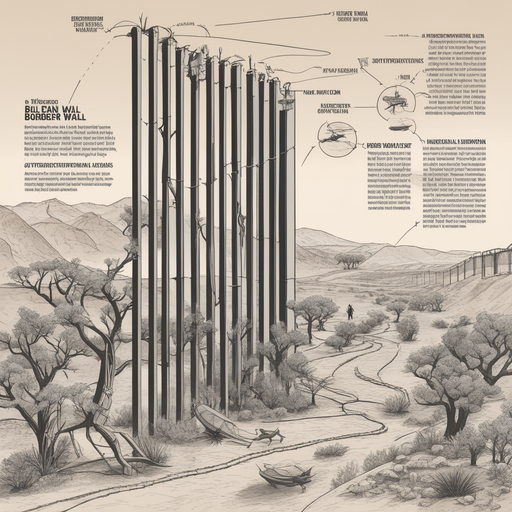 Biden Administration’s Border Wall Acceleration Sparks Outcry: A Closer Look at Environmental and Indigenous Rights Catastrophes
Biden Administration’s Border Wall Acceleration Sparks Outcry: A Closer Look at Environmental and Indigenous Rights Catastrophes
The Biden administration has recently announced that it will waive 26 environmental and cultural protections to speed up the construction of 20 new miles of border wall in Texas. This decision has sparked outrage among environmentalists, Indigenous leaders, and community groups who have been fighting against the harmful impacts of the wall on wildlife, ecosystems, and human rights.
In this blog post, we will explore why the border wall construction is a disaster for the environment and Indigenous rights, and what alternatives could be pursued instead.
The Environmental Impacts of the Border Wall
The border wall construction poses a serious threat to the biodiversity and ecological integrity of the borderlands. The wall would cut through some of the most diverse and fragile habitats in North America, such as the lower Rio Grande Valley national wildlife refuge, home to more than 500 species of birds, 300 species of butterflies. The wall would negatively 89 endangered species and 108 species of migratory birds that call the area home. The wall could lead to the loss of several endangered species, including:
- Jaguars
- Mexican gray wolves
- Ocelots
- Sonoran pronghorns
- Cactus ferruginous pygmy owls
The wall would also disrupt essential wildlife corridors for endangered animals such as ocelots, jaguars, and Mexican gray wolves, reducing their chances of survival and recovery. Moreover, the wall would increase habitat fragmentation, erosion, flooding, and invasive species, as well as interfere with natural water flows and migration patterns.
The environmental impacts of the border wall are not only detrimental to wildlife, but also to human health and well-being. The wall would exacerbate air pollution, noise pollution, and climate change by increasing greenhouse gas emissions from construction vehicles and materials. The wall would also limit access to clean water, food, and recreation for border communities who depend on the natural resources of the region.
 The Indigenous Rights Impacts of the Border Wall
The Indigenous Rights Impacts of the Border Wall
The border wall construction also violates the rights and interests of Indigenous peoples who have lived in the borderlands for centuries. The wall would destroy or damage sacred sites, burial grounds, cultural landscapes, and ancestral homelands of various tribes such as the Carrizo/Comecrudo Tribe, the Lipan Apache Tribe, the Kickapoo Tribe, and the Tohono O’odham Nation. The U.S.-Mexico border crosses several Indigenous territories and divides these communities. The barrier cuts through and/or affects at least 29 Indigenous tribes, including:
- Kumeyaay Nation
- Tohono O’odham
- Lipan Apache
- Kickapoo TribeYsleta del Sur Pueblo
- Carrizo/Comec
- Rudo Tribe
The wall would also infringe on the religious freedom, self-determination, sovereignty, and consultation rights of Indigenous peoples who practice ceremonies and rituals that involve crossing the border or accessing natural elements such as peyote. Furthermore, the wall would increase the risk of violence, discrimination, and harassment against Indigenous peoples by border patrol agents and vigilante groups.
The Alternatives to the Border Wall
Given the devastating impacts of the border wall on the environment and Indigenous rights, it is imperative that the Biden administration reconsider its decision to waive protections and continue construction1. Instead of building a wall that is ineffective, wasteful, and harmful, there are better alternatives that could address the root causes of migration and promote security, cooperation, and justice in the borderlands.
Some of these alternatives include:
- Investing in humanitarian aid and development: Providing assistance and support to migrants fleeing violence, poverty, corruption, and climate change in their countries of origin could reduce the need for migration and improve living conditions in the region.
- Reforming immigration policies: Creating a fair and humane immigration system that respects human rights, provides legal pathways for asylum seekers and refugees, and reunites families separated by deportation or detention could foster a more welcoming and compassionate approach to migration.
- Enhancing cross-border collaboration: Strengthening partnerships and dialogue with Mexico and other countries in Central America on issues such as trade, security, environment, health, and culture could foster mutual understanding and cooperation in addressing common challenges.
- Protecting biodiversity and Indigenous rights: Restoring habitats damaged by previous wall construction, expanding conservation areas and wildlife corridors, enforcing environmental laws and regulations, and respecting the rights and interests of Indigenous peoples could preserve the natural and cultural heritage of the borderlands.
The border wall construction is a disaster for the environment and Indigenous rights. It is time for the Biden administration to stop this destructive project and pursue alternatives that are more effective, sustainable, and humane.




